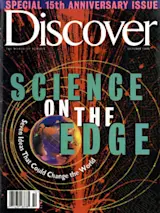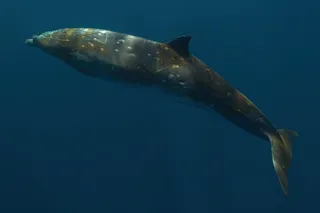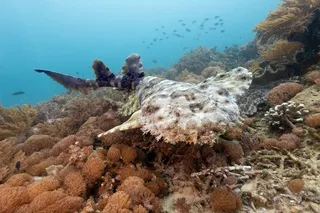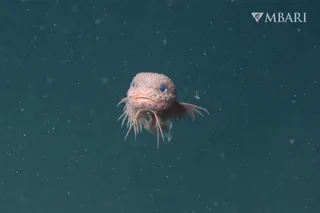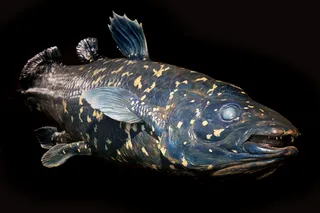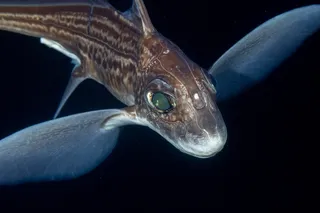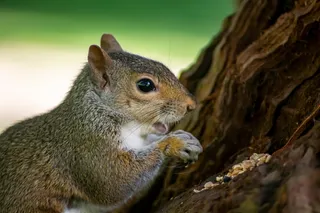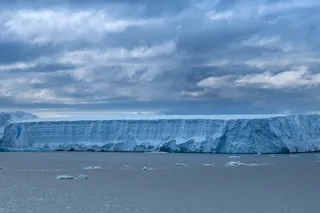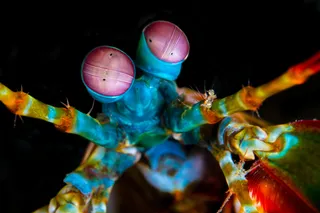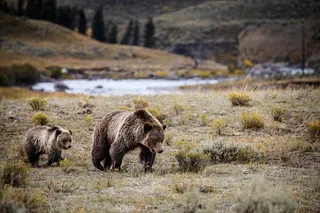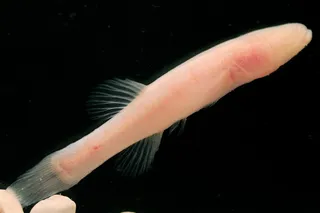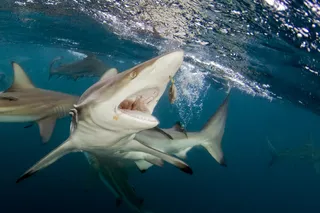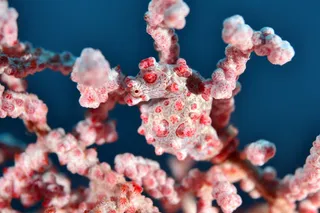The more you think about life on land, the less sense it makes. Life started in the ocean about 4 billion years ago, and for 3.5 billion years, it remained there. Evolution created organisms that had to stay wet- -they were essentially fluid-filled bags, and if they dried out, their circulatory systems would collapse, and most of their proteins and DNA would crumple up into uselessness. Without the ocean’s nutrient-filled currents, they would starve, and they and their fragile eggs and larvae would be immobile, unable to reach new or better habitats.
Seen from the sea, then, the land should equal death. Yet since animals, plants, and fungi first came ashore some 450 million years ago, life on land has been outrageously successful. True, land organisms have had to remain fluid-filled, DNA-based sacs, and they still rely on the old- fashioned, oceanic ways of getting food and energy, such as predation and photosynthesis. But according to the best estimates, there are now twice as many species on land as there are in the seas, and they produce some 50 times as much biomass. Furthermore, they manage this on only one-third the ocean’s breadth and in only a tiny fraction of its depth. And they achieved these luxuriant statistics in very little time. If ocean life were a 100- year-old man, life on land would be an 11-year-old child.
Researchers have tried to explain this land-sea paradox, in bits and pieces, without much success. But Mark and Dianna McMenamin, a husband- and-wife paleontological team, have an imaginative new hypothesis that they believe can explain it all, at one go. To understand the success of life on land, they say, you have to recognize that it is a unified whole. What makes it different from marine life is that unrelated terrestrial organisms--plants, fungi, and animals--form a vast number of direct, physical connections through which fluid can move. In effect, the McMenamins claim, life on land has not so much forsaken the sea as created a new sea within the sum of its tissue--something Dianna and Mark have dubbed Hypersea.
Hypersea is in many ways different from an ocean: for starters, it has no surface on which you can gaze, and it does not seek to be level. If you could look at life on land through a machine that registered only fluid, you would see great columns of nutrient-laced water rising--the columns would be where trees stand. You would see water flowing horizontally underground among plant roots and fungi, pouring into animals as they fed, moving as the creatures moved. According to the McMenamins, this liquid matrix has become Earth’s newest aquatic habitat, one that marine organisms have aggressively colonized. And in critical ways it behaves exactly like an ocean: the movement of fluid through Hypersea provides life with the same sustenance that ocean currents do. But there is one notable difference in the life it feeds: rather than being passive beneficiaries of an ocean that surrounds them, land organisms can control the currents within them. Thus, viewed as Hypersea, life on land couldn’t help being a smashing success.
The McMenamins propose Hypersea not as metaphor but as reality. If they are right, and Hypersea does actually ripple through all the plants on the surface of Earth, all the insects, the birds, the reptiles, the mammals, all the cells in all the bodies that crawl or walk upon the land, the implications are as vast as the sea itself. Hypersea not only offers, for example, an explanation for the largely mysterious emergence of life on land but it also suggests a number of bizarre life-forms that should once have existed and perhaps still do. It explains not only the land’s greater biomass and biodiversity but also such mysteries as why terrestrial food chains are so much shorter than marine ones. It could provide agricultural and medical researchers with new ways to understand pests and diseases. It could even reveal the future of evolution.
Of course, the Hypersea hypothesis can also be proved wrong. And the McMenamins have considerately offered their colleagues a number of ways to do that.
The idea of Hypersea began seeping quietly into the individual minds of the McMenamins in the late 1970s. It came to Dianna while she was an undergraduate at the University of California at Santa Barbara, coinciding with her introduction to the underappreciated kingdom of the fungi. There are several hundred thousand species of fungus, and they are more closely related to animals than are plants. Among us humans, they have an unfortunate reputation as freeloading or fatal parasites--we tend to notice them only when they appear on the soles of our feet or in our refrigerators, or blight a country’s worth of potatoes. But without a fungus, bread would be matzo and beer would be barley juice. Without penicillin and other antibiotics produced by fungi, infections would have claimed millions more lives this century. Without fungi in the soil, most plants would die, because they are joined with fungi in life-giving symbiosis.
Fungi exist as a web of slender threads known as hyphae, many of which are only one cell thick. They have no mouths with which they can eat like animals, and they can’t photosynthesize like plants. What they do have are enzymes that can break down living tissue, dead organic matter, or even rock; fungi get their nourishment by releasing these enzymes and then soaking up the resultant slush through their cell walls. The hyphae of many species, known collectively as mycorrhizal fungi, invade the roots of plants and sometimes even their stems and plunge into their cells. Though the fungi seem poised then to suck the plants dry, they are in fact gentle neighbors. Mycorrhizal fungi take some of the plants’ carbohydrates, but in return they give minerals and other compounds.
Fungi form underground networks that unite forests of different plant species. Sometimes a network acts like a nervous system. When a plant is attacked by insects, some species of fungus can pump pesticides into it. If one part of a stand of trees is poor in nitrogen and another is short of water, fungi can transport the substances needed. And if the plants are starving, fungi can give them lumps of oil to feed on.
When Dianna was an undergraduate, one of her interests was the bizarre sex life of fungi. In many species, when two hyphae meet, they probe each other. If they are of different sexes--a matter of genetic, rather than genital, compatibility--they fuse and exchange genes. (Chances were good for such exchange in the species that Dianna studied--it has 5,000 different sexes.) After mating, fungi often produce aboveground structures such as mushrooms and toadstools, loaded with up to a trillion spores.
By the time she was ready for graduate school, Dianna’s interests had focused on questions relating to the origin of life, and she decided to study paleontology at Santa Barbara. But she soon found that when she would ask other paleontologists about the origin of fungi, they’d simply shrug. With few known fossils, fungal origins were a blank. In 1980, Dianna met Mark, when he too came to study at Santa Barbara. They soon married, despite his being yet another animal-centric, fungus-oblivious paleontologist.
Mark’s own career had grown out of a boyhood fascination with early life-forms. When he was ten, he paged through a book of fossils and was struck by a picture of an inch-wide disk with three curved rays radiating from its center. The book explained that this creature, a tribrachidium, was 550 million years old, and that no one had any idea what it was. I thought, this is very strange, Mark recalls. The tribrachidium was among Earth’s first multicellular animals, known collectively as the Ediacaran fauna (named after Ediacara, Australia, where the first fossils were found). These animals were flat, boneless, eyeless, mouthless, and brainless. About 530 million years ago they vanished during a burst of evolution known as the Cambrian explosion, which populated the oceans with almost all the major forms of life that have existed ever since. The whole focus of my graduate work was trying to locate these things, to try to find a new field site, says Mark. He traveled the length of North America searching for one. Eventually he found a rich vein of Ediacaran fossils in Mexico. The site has yielded dozens of new species, and Mark has become an authority on the first chapter of the story of animals. This past March he discovered a jellyfish-like animal at the site that is 590 million years old--the oldest known fossil of a multicellular animal.
Like other Ediacaran fossils, it is a humble blob. In their book The Emergence of Animals, the McMenamins hypothesized that these creatures lived in a world very different from ours, one that had ample room for humble blobs. They created their own food, so even though they were large, they were not predators, nor were they preyed on, says Mark. Some animals harbored photosynthesizing microbes in their tissues, while others harvested the energy in chemical compounds in the ocean. Some were just passive nutrient absorbers, picking up amino acids kicking around in the water. Mark likes to call this tranquil world the Garden of Ediacara.
For reasons that are still unclear, the Cambrian explosion brought the world’s first predators, complete with mouths and brains, and they swiftly destroyed the Ediacaran garden. But as Mark points out, there was an evolutionary upside: When you get those first predators, they force their prey to do new things. Your lineage gets helped by the things that are trying to eat you. Help, in this instance, means you develop armors and poisons and escape maneuvers. And then the predators undergo a diversification and you get an upward spiral, and in a few million years, boom, you fill the ocean with a plethora of new species.
In 1984 the McMenamins went to Mount Holyoke College in Massachusetts, where Mark had taken a teaching position. As they worked on their book on animals, Mark started overhauling his class on the history of life. When I looked at the textbook I was using, there seemed to be something missing, he remembers. For one thing, fungi were barely discussed. For another, he says, plants were mentioned, but peripherally, in little boxes. This seemed like a serious oversight. The one thing I kept coming back to was coal. In their study of early life, the McMenamins had noticed an odd coincidence. During the Cambrian explosion, dry land was occupied by only a varnish of bacteria. But within 60 million years, plants and animals arrived, and less than 100 million years after that, life on land was already more diverse than in the oceans. Land plants were forming forests so vast that they created a kind of rock never seen before: coal. For billions of years there’s no coal, says Mark, and then suddenly there’s a new rock. No one had been able to solve the mystery of how a biological process so powerful that it became a geologic force could burst on the scene so quickly.
Mark became consumed with studying this second explosion. We spent a lot of time talking back and forth after he started doing his research, says Dianna. Mark would toss out explanations for this second explosion of life, and Dianna would shoot them down. (He has more ideas, I have better ones, Dianna claims.) In particular, she reminded him that any theory for the rise of life on land had to explain the mysterious origin of fungi. I kept hammering on him, saying, ‘Look at the fungi!’
Mark turned to a weighty fungus textbook for inspiration. I’m reading, and I think, I’m not going to read this whole thing. In all the articles, the interesting things are either in the throwaway comments at the end or in footnotes. So I open up the book to one of the later chapters, and there’s a discussion of weird cases. I’m reading along, and one weird case is this fungus called Septobasidium. And suddenly it just hits me: this is the essence of why life works on land.
Septobasidium is a fungus with a taste for animals--specifically, for waxy, mothlike creatures known as scale insects that live as seemingly immobile bumps on the branches of trees. The fungus forms a blanket that traps the insect against a trunk. Then it inserts its hyphae into the insect and absorbs its fluids. But the paralyzed insect doesn’t die--it actually lives longer and has more young than its uninfected counterparts. It survives by sticking a long feeding tube into the tree and sucking out the tree’s fluids. The tree, meanwhile, is drinking from a mycorrhizal fungus entwined with its roots underground. In other words, fluid is flowing from fungus into plant, from plant into animal, and from animal into fungus. Mark began to think of the other organisms connected to this association: the parasitic fungi that infected the mycorrhizal fungus, and the wormlike nematodes that latched onto the roots of the tree.
Septobasidium, the tree, and all the other organisms, he realized, fed on currents of fluid, just as many marine organisms do, but this fluid flowed through their own tissues. The various organisms had, in effect, created an ocean inside themselves. The more Mark and Dianna talked about this concept, the more it seemed to them that the whole effort of evolution on land had been to re-create the ocean internally and exploit it. Perhaps it started as an act of evolutionary desperation, but it was eventually able to create the staggering bulk and diversity of life that has lived on land ever since.
Comfortable as life might be in the ocean, it has its intrinsic limits. The organisms that live in the marine surface waters are in a perpetual state of famine, says Mark. They strip the surface water of its nutrients, and it takes a long time to replenish them. They scrub everything clean. With few exceptions, plankton can do nothing but wait for an upwelling of deep water. In the ocean, productivity is just little twinkles where you get upwelling, and at the fringes along continents. The rest is just desert.
The short pause between the Cambrian explosion and the advent of plants, animals, and fungi on land was probably no coincidence, according to the McMenamins. You had these brain-driven predators ruining the neighborhood, so the only safe place left was a marginal place where the animals hadn’t yet become serious predators, says Mark. Perhaps some protoplants and protofungi tried to scrape by along the shores, where they had to endure dry periods. The protofungi would attack the protoplants and usually kill them. But suppose a defective protofungus failed to kill its victim--it could stumble into a symbiotic relationship with the plant that allowed them both to thrive. As the protofungus broke up rock and consumed it, it supplied some to the protoplant. The protoplant, in turn, could stop depending on ocean currents for its nutrients and start evolving the structure and shielding to grow upright into the air. Once a plant could escape the water, it could immediately gather far more solar energy. Drying out from evaporation was a risk, but evaporation was also beneficial because it acted like a pump, pulling more water from the plant’s roots, laced with the fungal goodies, to its photosynthetic tissues.
What happens in this scenario, the McMenamins point out, is that suddenly the upwelling of the ocean that brings nutrients to the surface happens inside two kinds of cooperating organisms. Organisms have seized control of the nutrient flow, says Mark. Instead of marine upwelling, land life can harness hypermarine upwelling. No longer do the organisms have to suffer in passive starvation.
If the McMenamins are right, this happy combination should be preserved in the fossil record. As Dianna had learned, fungus fossils are rare. But they are not nonexistent, and Mark may have found some. Along with other researchers, he has been studying rocks from a 400-million-year- old pond in Scotland, and he has found spores in them that look exactly like those of modern mycorrhizal species. Last December, Winfried Remy of Westphalian Wilhelms University in Germany reported discovering in the rocks the unique bush-shaped tendrils that mycorrhizal fungi insert into plant cells. Without that, you might be able to say vascular plants were doing well on their own and fungi came along as camp followers, says Mark. But they seem to be right on the ground floor.
Ever since the creation of Hypersea, life on land has become increasingly successful whenever it has figured out a new way to exploit or control the new medium. Early plants, for example, still needed to let their gametes swim to each other in standing water. But within 50 million years they had figured out how to run this step of reproduction in their watery interiors. Only then did plants really start to race across the surface of the land, changing the face of the planet forever.
As this new fluid habitat of plants, fungi, and animals expanded across the land, it became an inviting frontier for exploration. Many marine species moved onto shore not by sprouting legs but by slipping into the blood or sap of land organisms. (Some, such as the wormlike pentastomes, have since become extinct in the oceans.) Land parasites follow the same rules in a body as fish do in the ocean. They navigate with sensors, detecting chemical gradients instead of light or odors. They camouflage themselves from their predators--particularly immune cells--with biochemical rather than visual cloaks. Like fish, parasites can be territorial. In some parasitic wasp species, the mother will lay several eggs in a host. All but one hatch early and cruise the host’s body, killing competing parasites so that the last larva to hatch has a habitat all to itself. As any aquarium owner knows, there is a limit to how many fish you can put in one tank; the same crowding effect takes place among parasites in a host. It’s like a living fishbowl, says Dianna.
Parasites’ similarity to fish in the ocean would seem to stop at migration, since here terrestrial parasites face an obvious problem: in many places their sea is disconnected. But like plants and fungi, parasites too can take control of Hypersea’s flow, directing it to get them from one host to the next. A dramatic example is offered by the worm Leucochloridium paradoxum. It matures inside snails, but to reproduce it needs to get inside a bird. Navigating its way through Hypersea, the worm moves into the snail’s eyestalks. Its presence there turns the eyes a bright red. Partially blinded, the snail crawls to the top of a plant in search of light. There the snail, with bright eyes in plain view, is easy prey for birds.
The evolution of parasites in Hypersea helps explain the diversity of life on land. Once ashore, parasites were forced to begin aggressively exploring the many environments available to them inside land life--indeed, the difficulties of living outside a watery host left them little choice. Each potential host, of course, was a unique environment requiring special adaptations, a situation that encouraged the parasites to diversify, and they did so with enthusiasm. They even turned other parasites into their homes. Like a set of Russian dolls, a host caterpillar may contain a parasitic wasp larva, which in turn contains another larva, which is home to yet another larva, and so on, so that the caterpillar carries five parasites in total. The effect of such specialization is made clear when you consider that, by at least one estimate, parasitic wasps and their parasites constitute 8 percent of the world’s biodiversity--equal to one-quarter of all the diversity in the oceans.
The diversity of life on land also gets a boost from the dense traffic of organisms and genetic material riding the rents of Hypersea through various organisms. My favorite example is the chestnut tree, says Mark. An Asian fungus has wiped out almost all chestnuts in the United States, leaving only their root systems. But a new strain of fungus has arrived. It carries an impaired virus that can live only in the fluid tissues of the fungus and that renders the fungus harmless to chestnuts. When the new fungus meets the old and the two engage in some fungal sex, the virus slips into the harmful fungus and neutralizes it. Now some foresters are claiming that the trees are recovering, notes Mark. The result, he says, is that the fungi act like a diversity pump. Instead of a tree getting wiped out by a parasite, with a net diversity of zero, you’ve got the tree still living, you’ve got two strains of the fungus, and you’ve got the virus.
Not just viruses but plain DNA probably gets traded frequently through the flow of Hypersea. The promiscuity of DNA in Hypersea has got to be tremendous, says Mark. He cites recent work demonstrating that the fungi and algae that together form lichen appear to have traded an extraordinary number of genes--to a degree never seen in marine life. There are a few examples of this in the ocean, Mark concedes, but they’re minor and puritanical.
The last time someone with scientific credibility claimed that life was united in some grand superentity was in the 1970s when organic chemist James Lovelock and molecular biologist Lynn Margulis suggested that the entire biosphere stabilized the composition and temperature of the atmosphere and oceans. They named the system Gaia. But while poetically delicious, the Gaia hypothesis doesn’t offer scientists a straightforward way to test it, and that has led many critics to call it unscientific. The McMenamins both admire Gaia, but they don’t think Hypersea will suffer its fate. Hypersea makes specific predictions that can be refuted, and Gaia in many ways is simply a metaphor, says Dianna.
Hypersea, they say, will rise or fall with future research into marine parasites, which have yet to be thoroughly studied. The McMenamins predict that there should be far fewer nested parasites in the ocean, that they shouldn’t compete much with one another within a host, and that they should survive better than terrestrial parasites outside host organisms. We also predict that the variance of virulence is bigger on land than in the ocean--more really bad parasites and others that are asymptomatic, says Mark. In marine habitats you’d expect a narrower spectrum of virulence, since the oceans are bathed in one medium. A virus can float all the way around the world.
Fungi also remain poorly understood, and these too can help test Hypersea. Since hypermarine upwelling is a key to success in Hypersea, the most successful plants should be the ones that can associate with the most species of fungus. This would allow them to hook into Hypersea again easily when they attempt to colonize new ranges. (The widespread Douglas fir, for example, can associate with 2,000 types of fungus.)
Yet another test would be to look for organisms that exploit Hypersea in ways allowed by the hypothesis but that are thus far unidentified. For example, just as marine animals have become terrestrial parasites, photosynthesizing algae or bacteria should also find an animal to be a fine aquatic habitat. Mark suggests that there are (or once were) terrestrial counterparts of the Ediacaran fauna, animals that survive by hosting photosynthesis. Whenever I give a lecture on Hypersea, says Mark, someone comes up to me and says, ‘I think there’s one out there, too, and I’m going to find it.’ Mark himself will hunt for fossils of such life- forms. I want to go into the Appalachian Mountains and look for evidence of unusual hypermarine linkages in these kinds of organisms. Maybe my photosynthetic land animal is there.
And what if all the tests bear out the hypothesis? What difference will it make to us if Hypersea is real? For one thing, we’ll have to realize that we humans are stirring it up like never before. Just as we have brought zebra mussels from Europe to the waters of the United States, we have probably brought diseases like AIDS very quickly from one reservoir of Hypersea (monkeys) to another (ourselves)--and in both cases, the invaders are wreaking havoc. We would benefit from manipulating Hypersea’s currents wisely. Some of the McMenamins’ biggest fans are experts in biological pesticide management, who kill pests with parasites. By thinking of hosts as connected aquatic environments, the McMenamins suggest, we could find new cures for the diseases afflicting crops and humans. By fashioning a fake NO VACANCY sign, for example, we could trick a parasite into thinking that an uninfected host was too crowded.
Hypersea may even offer hints as to where life on land is going. Hypersea is not like Gaia, a global union of life that keeps the world in a careful balance. Hypersea is life out of control, a rising tide building up biomass and speeding up evolution.
A corollary of the McMenamins’ hypothesis is that Hypersea suggests a way to predict the future of evolution. As an intriguing example, Mark cites mangroves. These coastal plants send some of their roots down into soil, where they join with fungi, and send other roots tens of yards into the ocean, where they trap sediment and create new soil. There are marine organisms beginning to associate with these roots, says Mark. There are sponges associated with them, and there are tests going on right now to find if there’s a nitrogen-hydrocarbon exchange between the sponges and the roots. I’ll bet you there is. Everything that I know suggests that this is going to be confirmed.
Mangroves might move out to sea and form giant floating islands. Their roots, dangling down below the starved surface waters to the nutrient-rich darkness, could join with sponges and other ocean organisms acting like fungi. The biological potential of this arrangement could be tremendous.
If it gets big enough, says Mark, you’ve got incredible pipelines. That’s going to have an immediate effect on carbon dioxide. As carbon dioxide levels fell, oxygen levels would rise, until they reached a point at which any terrestrial life other than mangroves might be endangered. At 35 percent atmospheric oxygen, Mark speculates, you could go out with a baseball bat and hit a maple tree and it would burst into flames!
Life wouldn’t come to an end, of course. There would still be the soggy mangroves and other marine vegetation to serve as Hypersea’s inheritors. In its fullest flowering, life would merely have gone back out to sea.


